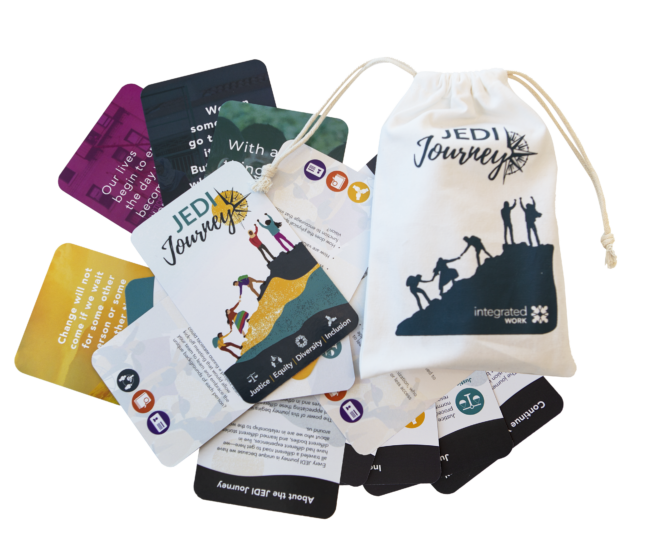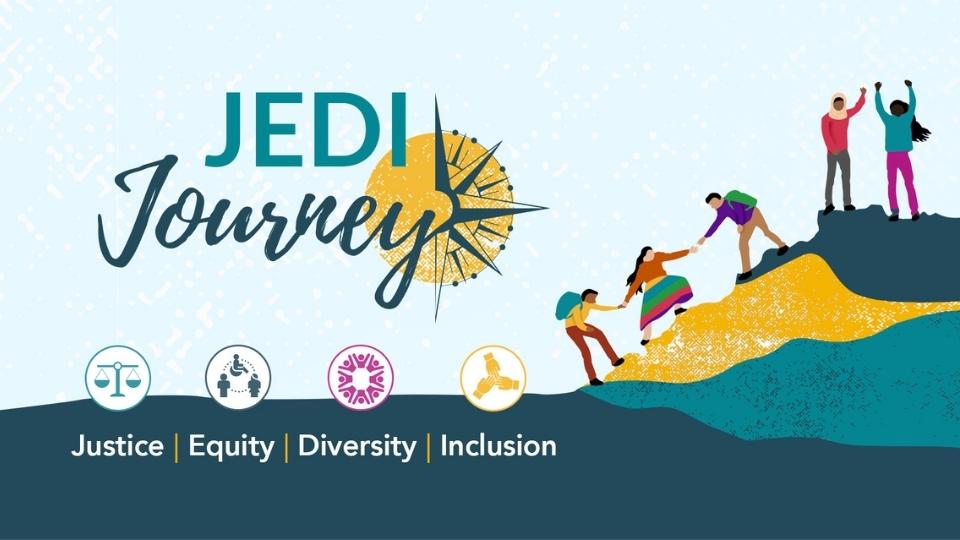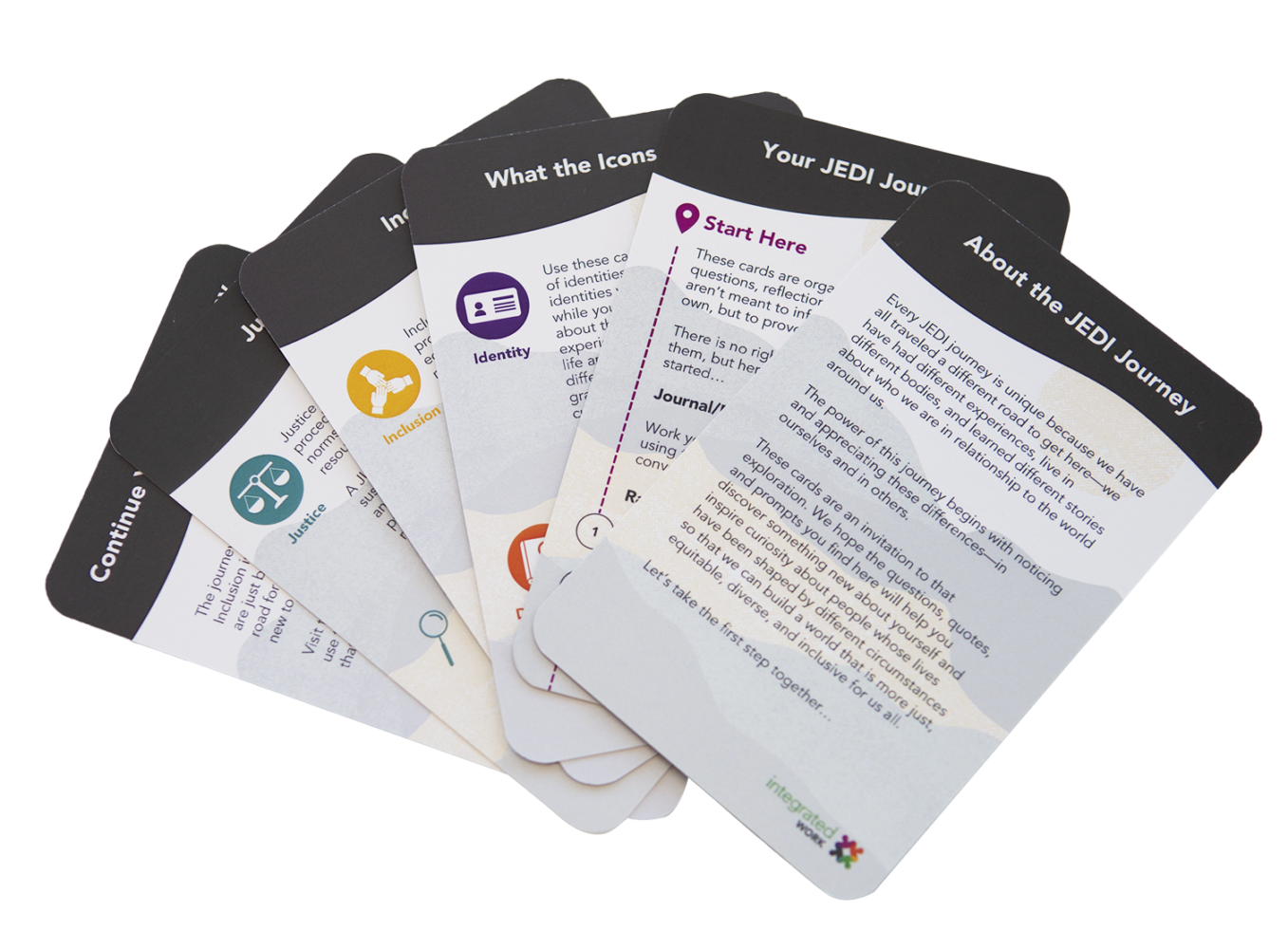By Trent Norman & JEDI Team
Updated in 2024
Justice, equity, diversity, and inclusion (JEDI) are complex topics — and many of us are unsure how to explore and learn more about them, especially in a workplace environment. As JEDI consultants who work with teams, we know these topics take time to explore and have no easy solutions. (If they did, would we still be talking about this?)
Our team created the JEDI Journey cards because we have a process to help people stay engaged in the work to create a more inclusive and equitable future.
We realize there’s a wealth of information available about justice, equity, diversity, and inclusion, but finding approachable resources can be a challenge. The JEDI Journey cards are designed as an accessible tool that can be used in a variety of settings — staff meetings, silent reflection, family gatherings, ice-breakers, and more. Each card helps people examine their experience(s) with justice, equity, diversity, and inclusion and explore how that influences them every day.
The JEDI Journey cards represent an opportunity as well as a direction to explore the topics in a meaningful and powerful manner. We designed them to help all of us:
- Stretch our understanding and knowledge as we engage with the JEDI topics at deeper levels beyond an interesting cognitive exercise.
- Start a practice of discussion and exploration with others.
- Engage more often with the topics of justice, equity, diversity, and inclusion.
The cards mirror the Integrated Work team’s philosophy about JEDI work: Growth and change occur when people explore the topics — alone and in groups — with curiosity and a human-first spirit. Including “journey” in the name of the cards reinforces that this is an ongoing process. To borrow from the Bard and nudge the saying a bit: “The journey is the thing!”
Prompts, Questions, and Reflections to Advance Each JEDI Journey
Now that I’ve shared the reasons behind the JEDI Journey cards, let’s take a closer look at using them.
The 65-card deck includes three types of cards:
- Identity cards that encourage people to explore the characteristics that help define their sense of self.
- Definition cards that provide background and knowledge to inform discussions.
- Discussion cards for each topic — justice, equity, diversity, and inclusion — that provide questions, reflections, and prompts.
Instead of seeking to provide “the” definition of a topic, the cards offer an example, encourage exploration of other definitions, and invite the user to make meaning of the definition(s) that resonate with them. Rather than provide a formula — “do X when Y happens” — the cards encourage people to explore a variety of skills and actions that could be useful in different situations.
Join My JEDI Journey Card Exercise: Age, Access, and Inclusive Spaces
For this exercise, I selected the Age, Access, and Imagining an Inclusive Space cards. Because age is the general theme based on the first card, I will consider ageism as I answer each question. There are many ways to define ageism, and identifying a definition can be a part of the exercise. For this purpose, I will think about the loose definition that ageism is discrimination based on age/years of experience (in a job, on the planet, etc.).
From the Age card, I chose the prompt: “Describe how you think about your age/generation.”
Unlike some other parts of my identity, my age shifts each year. As I’ve grown older, I mark the shifts by a single year rather than in larger chunks, not unlike when I was very young. When I was in my 20s and 30s, those felt like “decades” – large chunks of time. Time seemed like a commodity with large resources. As I’ve aged, that has felt less true. No real surprise: As mortality has an ever-approaching due date, my orientation to my age has altered my vision in a way. Now each year feels more like a mile marker with a scenic overview and less like a blip in the longer journey of life.
From the Access card, I chose the prompt: “If you look at your organization, who appears to have more or less access to leadership?”
To answer this question, I’m going to choose my part-time role as a ski instructor at one of the big ski resort companies. My role is specialized: teach you how to make the skis go right and left down the hill in control. My exposure to other parts of the organization is fairly limited to interpersonal interactions with other employees: food services when I grab lunch, lift operations, and transportation when I’m on the bus. There are others, but that is the bulk of it.
The ski industry thrives on new blood but is founded on tradition. Relationships are important, and the business model of the large organization that owns several ski resort areas (including the one where I work) tends to have a cloistered set of executives, often one executive moving from one location to the next. From my position, it appears that the people in those top positions range from 40 to 60 years old — consistently.
Getting to that level requires that individuals spend time at the many resorts learning the management end of the business until they are ready to break into the executive realm. It appears that few people from different age ranges are represented in top leadership. Despite being a business run by younger people on the surface, the power and decision-making reside with an older set of people.
From the Imagining an Inclusive Space card, I chose the prompt: “Describe what an inclusive workspace looks like.”
This card encourages me to imagine an inclusive workspace with age as a filter. Going back to my ski resort example, a place inclusive of age can have a lot of different meanings. At the executive level, a space inclusive of age could look interesting. The organization has a typical business structure: President, Chief Executive Officer, Chief Operations Officer, etc. Because this is a large, multi-facility organization, being inclusive of age at that level might be challenging.
I will not begrudge the organization’s tactic of nurturing top executives with a variety of experiences; indeed, I believe it helps keep their product somewhat consistent. But that consistency may also present challenges. You can be guaranteed that nothing too radical will impact the organization, as the people in charge have vast and extensive knowledge of the way it runs. The enthusiasm, new views, and vigor of youth may not have the same influence that it might at an organization with a more age-porous orientation — like a technology startup, for example.
One method to shift ski industry culture would be to include an apprentice program for newer employees. Spending six months to a year in a specially designed executive (in training) position might allow someone to gain a different insight into the organization’s operations, allow them to have more significant influence sooner, and increase the pathway for long-term employment. (In addition to the youth movement at the lower levels, there’s also a bit of exodus at those same levels.) This mentor program should be designed to increase the flow of ideas and energy in all directions, fostering a culture of mutual learning across the mentor relationship.

Reflections from My JEDI Journey Card Exercise
I appreciate how the cards encourage us to think at deeper levels and reinforce a human-first mindset — a concept central to how we operate at Integrated Work. With that perspective, I see how age presents an interesting challenge in examining an organization. When I worked at a land-grant university, the age barrier was much more pronounced and much less porous. The age conversation there would be very different than with a large, multinational organization or a technology startup. How many university chancellors and presidents are in their late 20s? How many technology startups have a CTO that is ready to retire? The story my brain tells me is that it is not many in either case — probably zero in the former — and yet the cards prompted me to think about age.
Another interesting discovery from this prompt is that I recognize the implications of making wholesale changes to how organizations are structured. The example of how to affect the age balance among executives at the large ski resort organization comes with its own set of issues. People “earn” the right to be in those executive positions, and that has meaning. Likewise, the freshness of youth in an industry that relies on younger workers to keep the operations going also has meaning. Chloe Kim and Mikaela Shiffrin might be better-known household names now than Ingemar Stenmark, Ron LeMaster, or even Hank Kashiwa — yet all of them have affected the industry. I think the challenge is in finding balance. For the ski industry, one could not exist without the other.
JEDI Journey Cards Can Help Us Navigate Differences and Move Toward a Better Future
As you can see from this example, each of our answers and thoughts for prompts and questions will be different. Those differences are part of our JEDI journeys, as each of us travels a unique road through our life experiences and relationships with others.
At Integrated Work, we believe the actions of individuals committed to change can help us move forward on a path of healing and reconciliation that includes accountability, access, representation, and grace. With the JEDI Journey cards, we invite you to join others in noticing and appreciating our differences as we continue to learn and discover on the pathway toward a more inclusive and equitable future.


